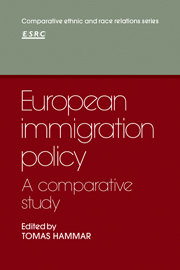3 - The Netherlands
Published online by Cambridge University Press: 05 November 2011
Summary
Immigration and immigration policy
A brief historical overview
For many years the Netherlands has had a reputation for its strong international orientation. The country's favorable geographical location enabled it to become the seafaring nation of Europe. In order to insure commercial contacts it built up a colonial empire of surprising dimensions, given the modest size of the mother country. Since the Reformation in the sixteenth century the Netherlands has also been known as a tolerant country, and it became a refuge for those who were persecuted on grounds of religious or political beliefs. Jews from all over Europe, Huguenots from France, Roman Catholics from Germany, and many other refugees have contributed substantially to the country's economic prosperity and cultural development. During certain periods there was also a substantial immigration of temporary and permanent workers from nearby countries. Many of these were employed in agriculture, while others served as mercenaries in the navy and the army.
On the other hand, commercial and other interests in many parts of the world have led to substantial emigration. Dutch people have settled in many former colonies (North America, Brazil, West Africa) and in some cases their descendants may still be traced quite easily (Burghers in Sri Lanka, Boers in South Africa). During the nineteenth century large groups of Dutch emigrants moved to the United States and to the former Netherlands East Indies. Since the Second World War, and especially during the 1950s, half a million people have left for “New World” countries like Canada, Australia, and New Zealand.
- Type
- Chapter
- Information
- European Immigration PolicyA Comparative Study, pp. 50 - 88Publisher: Cambridge University PressPrint publication year: 1985
- 7
- Cited by



